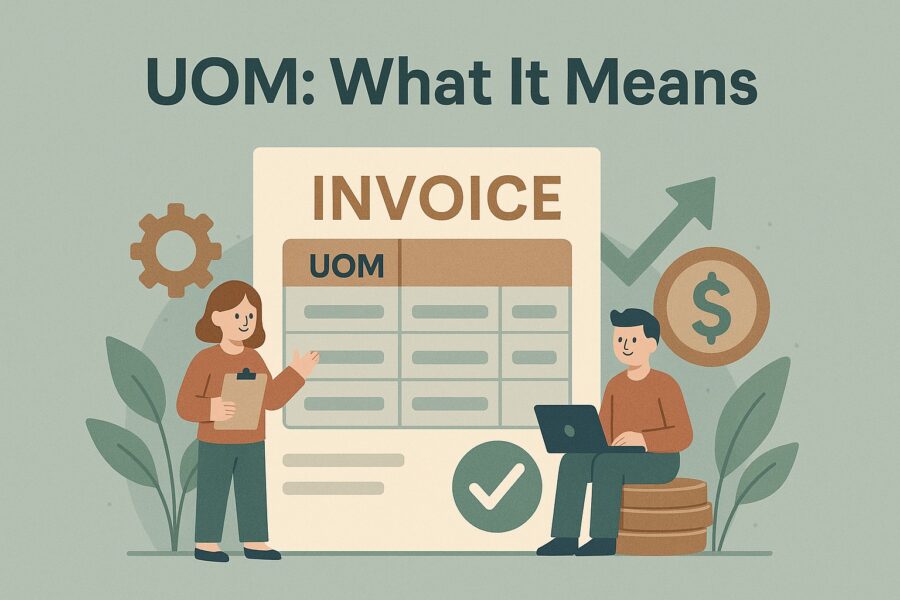What is UOM in Invoice: Meaning, Benefits & More
- 6 Nov 25
- 6 mins

What is UOM in Invoice: Meaning, Benefits & More
Key Takeaways
- UOM (Unit of Measure) defines how goods or services are quantified, such as kilograms, litres, or pieces, ensuring accuracy and transparency in invoices.
- Using standard UOMs prevents billing errors and maintains accurate pricing, helping businesses avoid compliance issues under GST laws.
- Proper UOM usage supports efficient inventory management, allowing timely restocking and preventing overstocking or shortages.
- Choosing the right UOM depends on product type and industry standards, ensuring consistency and clarity in both domestic and international trade.
- UOM is for business operations, while UQC is a fixed legal code used for GST reporting and e-invoicing.
If you come across units like kilograms or litres while accounting for goods on an invoice, you are dealing with UOMs. UOMs help quantify the goods or services being sold or purchased. They are vital for accurate inventory tracking, billing and cost management across both domestic and international transactions.
To better understand what is UOM in invoice, read on and learn how to interpret and apply it efficiently in your documents.
UOM: What It Means

UOM stands for Unit of Measure. Businesses use measurement units to quantify products or services in an invoice. This ensures transparency between buyers and sellers by highlighting the units of supplies made.
The common units of measure are as follows:
| UOM (Units of Measure) | Inventory Items Measured |
| Kilogram (Kg) | Rice, flour, vegetables |
| Meter (m) | Cloth, rope, wire |
| Litre (L) | Juice, milk, cooking oil |
| Pieces | Chairs, mobile phones, books |
Benefits of UOM in Invoicing
1. Eliminates Billing Mistakes
If you use standard UOM you can calculate accurate quantities for pricing and invoicing. This reduces errors in billing, helping your business avoid financial losses. Inaccurate usage of UOMs can result in incorrect returns and faulty bookkeeping, especially in invoices. This is a punishable offence under Section 132 of the CGST/SGST Act.
2. Improves Management of Inventory
Standard UOM helps businesses manage their inventory (stock level) efficiently. Businesses can restock goods at the right time to avoid product surplus or shortage, by referring to units of goods.
3. Builds Potential Supplier Relationships
As businesses can ensure transparency with suppliers with standard units of measurement, they can build stronger relationships with suppliers and stakeholders. Suppliers can rely on the standard UOM to transact products with businesses.
4. Cost-effective and Less Time-consuming
Switching between different UOM, such as 100 litres to millilitres or 100 kg to milligrams, can be time-consuming. However, with the use of standard UOM, the measurement becomes seamless, less time-consuming and cost-effective.
5. Adherence to Legal Standards
Indian taxation laws mandate businesses to comply with proper invoicing standards (purchase invoice). The use of standard UOM helps your business adhere to legal requirements, while you avoid penalties and additional charges.
How to Choose the Right UOM for Your Business?
Now that we know what is UOM in invoice, let us find out how to choose the right one.
Based on the type of goods, the UOM varies in invoices. As a result, it is essential to identify the product type before creating an invoice. Here are the factors to consider while choosing the right UOM:
Type of Goods Identification
UOM varies based on the type of goods being transacted. UOM for solids like wheat and rice differs from UOM for liquids and materials, like milk and cloth. Ensure you categorise the product type correctly to use the right UOM.
Industry Standard Compliance
Standard UOM is applicable across the globe for different products. Ensure you use the UOM as per your industry standards to avoid confusion and conflict with stakeholders.
Consistent UOM Selection
Ensure you choose a UOM that is accurately applicable. Further, you need to choose the UOM at the beginning of the transaction and continue with it consistently to avoid discrepancies.
Use of Custom UOM
Certain businesses have predefined packaging needs. As a result, such businesses use definite UOM such as 'cartons' or 'packs'. If you are operating in the same industry, you need to use such a standard UOM.
💡If you want to streamline your payment and make GST payments via credit, debit card or UPI, consider using the PICE App. Explore the PICE App today and take your business to new heights.
Difference Between UOM and UQC

Several individuals, especially those using Tally ERP, TallyPrime, SAP or involved in GST filings, often confuse UQC (Unit Quantity Code) with UOM. Though they may seem interchangeable, mixing them up can trigger compliance errors, invoice rejections and misaligned inventory data.
Thus, it is essential to understand the differences between the two:
| Parameter | UOM | UQC |
| Purpose | Inventory management and business operations | Legal reporting under the GST system |
| Use | Inventory, Tally entries | e-invoicing, GSTR-1 filing |
| Standard | Standard Units | Fixed codes are provided by CBIC (Central Board of Indirect Taxes and Customs) |
| Examples | Pieces, Boxes, Packs, Kilograms | NOS, MTR, KGS, LTR |
| Data Format | Abbreviations or full words | 3-letter code |
| Editability | Editable | Not editable, fixed by law |
Conclusion
To answer what is UOM in invoice, it needs to be mentioned that these are standard units of measurement accepted across the globe. Standardised units help maintain parity across different quantities of goods or services. Based on the type of product, your UOM will be applicable.
Ensure you identify the product type to use the correct UOM in invoices. This will help you avoid pricing and billing errors.
 By
By 

















